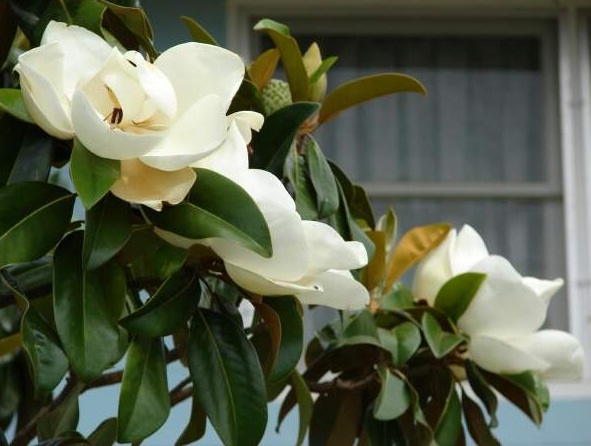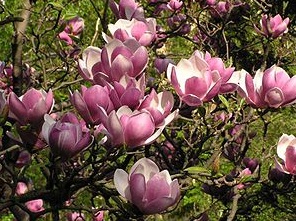Categories
Calendars
Guides
Reviews
Archive
Gallery
Articles
Ask Our Gardening Expert
Magnolia
Some Magnolia Varieties
Type
Description
Magnolia liliiflora ‘Nigra’
Deciduous to 3m with erect flowers, blooming in late spring
Magnolia X loebneri
Magnolia X soulangiana hybrds
Small trees up to 5m, flowering on bare branches.
Magnolia grandiflora, deudata and sieboldii
Most common scented magnolias
Type
Magnolia are outstanding spring flowering trees, appearing when most other deciduous trees are yet to flower and produce leaves. Their thick, waxy petals form wine-glass shaped blooms on bare branches. The trees are a delight in any medium to large garden. The smaller magnolias are better suited to average suburban garden, although they all grow large.
Magnolia grandiflora
They are a botanically interesting tree, appearing prior to bee pollination. The flowers are tough and developed to encourage pollination by beetles and they have no distinct sepals and petals. Magnolias are native to South East Asia, eastern North America, Central and South America and the Caribbean.
Magnolia liliiflora
Magnolias need room to develop, so plant less precious shrubs and perennials in their immediate vicinity and give the magnolias space to grow as they do not easily tolerate moving. They are surface rooting, absorbing nutrients from decaying leaf mould on the forest floor and will benefit from distributing well rotted compost over the root zone soon after planting. If they need to be transplanted, as large a root ball as possible should be taken. Should the root ball be shaken out, at least a third of the branches should be removed.
.
Spring flowering deciduous and evergreen tree
Growing Conditions
Freely draining organic-rich soil, sunny or slightly shaded sheltered position. Tolerates low temperatures. Allow for growth.
Care
Mulch with well rotted compost over root zone. Prune to shape and tolerates training.
Propagation
Commercially grafted, semi-ripe heel cuttings and layering. Can be reared from seed.

Magnolias need little pruning but the can be shaped to fit a smaller growing space. They can be trained as desired, to form a wide spreading or a single-trunked tree. They all pass through a straggling establishment phase with few flowers followed by a leggy phase. Size can be limited by an annual pruning after flowering. As the plant matures, branches adopt a more horizontal posture with many more flowers. With grafted plants, it is important to check strong growths to see if they originate below the union and will have to be removed. Leaf shape and bark texture is a good guide. Magnolias respond to training.
Magnolias are generally trouble-free. A common problem is bacterial leaf spot appearing on early season leaf growth in moist, warm conditions. This can be controlled by a copper based spray 2-3 weeks apart.
Propagate from semi-ripe heel cuttings or layering. Seed may be planted but seedlings will takes some years to develop into plantable trees.